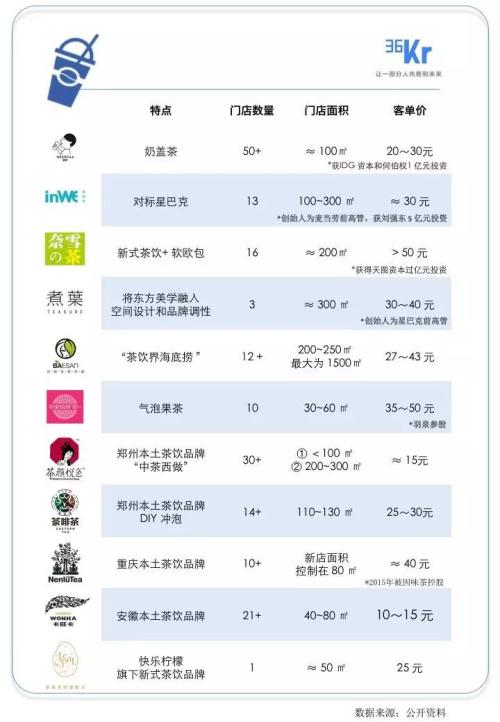Will the next Starbucks appear in the field of "new tea" when tea is hot? (I)
This time we studied whether there is an opportunity for the birth of the next Starbucks in the new tea industry, and the next time we want to return to the original main line, by analyzing the data and growth path of listed companies at home and abroad, to explore the sub-areas where too big brands have been born in the industry, but the original brands have aged and the opportunity window for the birth of new brands has been opened.

In this report, we focus on the following issues:
1. How big is the size of Starbucks that new tea drinkers generally target?
2. Is the tea industry big enough for the next Starbucks?
3. What are the key elements for the birth of the next Starbucks in a new tea shop?
Wen| Yuan Ling Deng Hen Hen Siqi Village Chief He Peikuan
Every day since wedding tea became popular last year, new tea brands have appeared on the streets or next to luxury stores.
At present, about tea drink, people discuss much, capital also pays much attention.
These tea brands are called "new tea drinks" or "fine milk tea", and compared with the stall milk tea shop, they have the characteristics of good raw materials, high prices, space upgrades and so on. Among them, there are brands that have received capital attention: Xi tea, taste tea, Naixue tea, boiled leaves, etc.

The picture above shows the main new tea brands on the market today.
Tea drinks are concerned by capital, and we think the main reason is that capital hopes to find "the next Starbucks" among them.
So why is China's next Starbucks more likely to emerge from a tea brand than a coffee shop?
On the one hand, coffee as an imported product, the market scale in China is not very large, the overall market is about 70 billion yuan. According to the beverage industry data report released by Kamen and Meituan Review Research Institute, in 2016, the number of cafes nationwide exceeded 10W, but the industry grew negatively throughout the year, and a new round of reshuffle appeared in the industry in the second half of the year.
Therefore, even though foreign brands such as Starbucks and COSTA have gradually cultivated Chinese interest in coffee in recent years, traditional cafes have many problems such as excessive asset structure, large initial investment, high operating cost and long profit cycle. As far as coffee is concerned, the imagination of new brands is limited, but it is new operating models that attract more attention, such as automatic coffee vending machines, coffee carts, etc.
The category of tea was rigidly divided into traditional Chinese tea and milk tea in the past. The emergence of new tea drinks combined the two consumption scenarios and produced wonderful chemical reactions. For China, which has a long tea culture, tea drinks have greater imagination and even have a huge opportunity to reverse output and become a global brand.
Therefore, in this research paper, we will focus on exploring and answering this question: what opportunities can we see in China's new tea industry? In other words, can the next Starbucks be born in the new tea industry?
1. How big is the size of Starbucks that new tea drinkers generally target?
Will the next Starbucks be born when we propose "new tea" industry?" When we ask questions, what we want to discuss is whether a large company with the same size as Starbucks or even surpassing Starbucks can be born in this industry. So, the first thing we should be clear about is: How big is Starbucks?
As a global coffee chain brand, Starbucks has a market capitalization of 89.2 billion US dollars so far.
According to Starbucks 'fiscal 2016 earnings data, its fiscal 2016 revenue reached $21.3 billion, and its net profit attributable to Starbucks was $2.8 billion.
Starbucks currently has about 26,000 stores in 75 countries around the world, with more than 2300 stores in China. And Starbucks plans to open 12,000 new stores worldwide by 2021, when the number of Starbucks stores in the mainland of China will reach 5000.
In terms of market share, Starbucks is also far ahead in the global chain coffee market. According to Euromonitor's 2016 statistics, Starbucks occupies more than 40% of the global chain coffee market, and its annual sales are more than the sum of the sales of its main competitors such as COSTA and Donuts.
So is china's tea industry big enough compared to starbucks? Can you support a listed company like Starbucks with a market capitalization of nearly $100 billion?
According to our research, China is a traditional tea producing country, but also the world's only oolong tea, Pu 'er tea production and export countries, and the world's largest green tea production and export countries. At present, China's overall tea market is 300 billion yuan, and the tea market is about 75.6 billion yuan. From a numerical point of view, China's tea and tea market has not yet reached the scale of 100 billion US dollars. What about the long-term growth potential?

On the consumer side, there is still room for growth in China's tea consumption market.
On the one hand, although China is a big tea consumer, according to the data of the International Food and Agriculture Organization, China's per capita tea consumption only ranks about 20th in the world, far lower than Turkey, Ireland, Britain and other big tea consumers, and has a big gap with China Hong Kong, Taiwan and other regions with the same cultural background.
Interestingly, China's tea consumption is still growing rapidly. For example, from 2001 to 2003, China's per capita tea consumption was 0.38 kg/year. From 2011 to 2013, this figure more than tripled to 1.04 kg/year, with an average annual growth rate of 10.89%, maintaining a very high growth rate.
In addition, from the perspective of tea consumption habits in micro-regions, tea consumption in developed cities such as coastal areas in China is relatively high, and Guangdong ranks first in per capita annual drinking volume, which is more than 2kg/year, exceeding 1.94kg/year of British people.
On the other hand, the potential market for Chinese tea consumption is still very large. According to the survey data of the National Tea Technology System Economic Research Office, there are nearly 500 million tea consumers in China, accounting for 36% of the total population, of which 254 million are urban consumers and 214 million are rural consumers. Compared with the total population, there are still many potential consumers (especially the younger generation consumers).
In terms of tea products, according to the statistics of Euromonitor, a market research company, the size of China's tea beverage market has reached 75.626 billion in 2010. With the impact of factors such as consumption upgrading and pursuit of health, this figure will also be projected onto the consumption of new tea drinks. In other words, in addition to the increase in the tea market, tea drinks are more acceptable to young people because of the addition of a "drink" element, so the incremental opportunities are considerable.
Therefore, on the whole, the domestic tea consumption market is still in the early stage, and has not yet reached the scale of 100 billion US dollars, but its potential consumption is huge and its growth momentum is full.
Therefore, after the above analysis, we find that from the perspective of market scale and volume alone, the scale of China's tea industry is a large market of 100 billion yuan. Although its market size is still one order of magnitude different from that of coffee market at present, its growth momentum is full, especially after integrating the consumption role of a new generation of young people, its incremental imagination space is huge.
Important Notice :
前街咖啡 FrontStreet Coffee has moved to new addredd:
FrontStreet Coffee Address: 315,Donghua East Road,GuangZhou
Tel:020 38364473
- Prev
Of the seven strangest kinds of coffee in the world, the last one is too strong!
Take an inventory of the seven strangest coffees in the world and see if you, as a coffee expert, have all tried 1. In Vietnam, Egg Coffee (Egg Coffee) mixes condensed milk and egg yolk until it thickens, and then pours the black coffee, which is said to taste like coffee-flavored casserole (cream yolk). This method of drinking is particularly popular in Hanoi, Vietnam. two。 United States, sweet cone cup
- Next

Will the next Starbucks appear in the field of "new tea" when tea is hot?
Can the market size of the tea industry accommodate the next Starbucks? What is the key to the birth of the next Starbucks in a new tea shop? Although we use the above space to demonstrate the scale and potential of China's tea market, the existence of the market does not necessarily mean that there will be monopolistic oligarchs in this industry, and there are also many industries with a huge market, such as Chinese catering.
Related
- Why are the coffee in some coffee shops not enough after being frozen? What should I make up for my American latte cappuccino coffee after being frozen?
- How much water does it take to steam coffee by hand? Why is the coffee brewing and steaming time 30 seconds? What is the purpose of steaming coffee?
- The suspected drink contains too much caffeine! Overlord Tea Lady responds urgently!
- Starbucks rejects antique paper coupons?! Netizen: Missed marketing opportunities!
- What ratio of water temperature and ground does the smart cup method use to press coffee? The difference between brewed coffee and filtered coffee?
- What is the standard process for the purpose of coffee cup testing? What is the difference between hand-brewed coffee and cup testing?
- How to use hand-brewed coffee paragon small golden balls? How does cold coffee lock in the aroma of coffee?
- Is American coffee black? What is the difference between American coffee and drip coffee?
- Unexpected! Well-known tea beverage brand Lele Tea will withdraw from the Zhengzhou market!
- Starbucks enters the fashion and beauty industry?! Netizen: Give me an ice American eye cream

